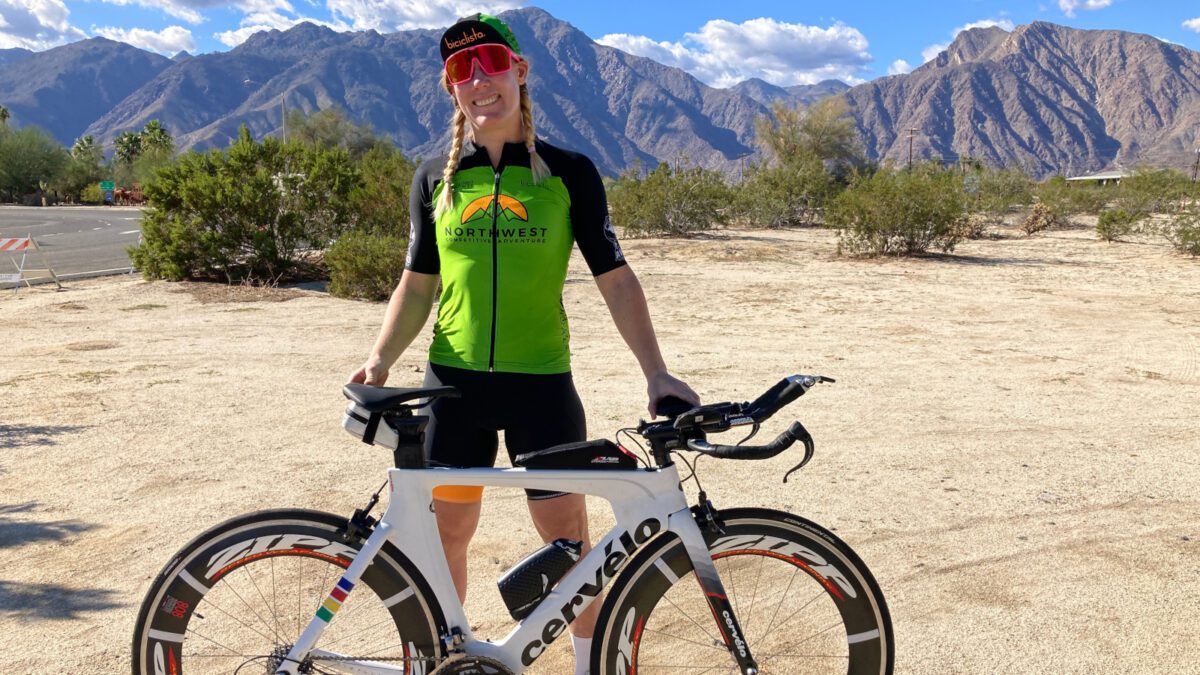What it takes to win the 24-hour world time trial championships
Meaghan Hackinen completed an incredible 770 km in the race

On Nov. 4 and 5, Meaghan Hackinen won the 24-hour world time trial championships in Borrego Springs, Calif., riding 770.5 km in 23 hours, 51 min, 29 seconds. She also beat the previous course record of 740.298 km that she set in 2019. She also placed second overall, outpacing every single male rider, save for one.
The race takes place every fall, and this year, Hackinen wasn’t sure how she would do.
“I wasn’t feeling particularly confident going into this one. Maybe it’s because the event was so late in an already jam-packed season and I was approaching burnout, but I’d also suffered a knee injury after I finished the Transcontinental Race in August and came down with a terrible cold that lingered in my lungs after the BCBR Gravel Explorer in late September. I procrastinated on booking my flight to California until less than three weeks out, at which point I went all in: structured training, heat adaptation protocol, daily juicing and no alcohol,” she explained. “By the time I arrived in Borrego Springs I was calm, prepared, and ready to compete: I arrived with a pacing strategy based on historical power data and my legs were feeling great from the taper.”
During the event she was sure to be focused on her pacing. In the past, she’d gone out too early, and wanted to make sure that didn’t happen again. “I’d gotten in trouble before for getting caught up in the excitement and going out too hard, then subsequently blowing up in the middle of the night. I didn’t want to suffer through that experience again,” she explained. “The race kicks off at 5 p.m. and for the first few laps I just settled in, enjoyed the sunset, and let my eyes adjust to the night. Then my pesky inner critic started up. I became anxious and questioned my pacing strategy: it felt too easy. Maybe I wasn’t pushing myself hard enough? Maybe I should kick things up a notch or two and really go after it? In the end I decided to play it safe and stick to my original pacing plan.”
Twenty-four hours is a long time on a bike, but each section of the ride has its different challenges. When asked what the toughest part was, she said it’s not the first few or last hours. It’s in between. “The middle—or as novelists refer to it, “the muddle”—is definitely the toughest for me. You’re out there riding loops in the desert; it’s dark and lonely and getting colder by the minute. Like years’ previously, I asked my crew to refrain from telling me my ranking until the morning so that I could focus on riding my own race, but without this information I felt like I was drifting through space, totally disoriented. The only thoughts running through my head were “keep a straight line” and “keep your power steady” as I counted down the hours until the sky lit up again in glorious sunrise.”
Eating on the bike is, as you can imagine, crucial for a 24 hour race. You can’t eat too much, or too little, and riding on a bike can be tricky for such a long distance.
“According to my power data, I burned a whopping 15,000 calories—that’s 625 calories an hour! F2C Nutrition is one of my product sponsors and I fuelled primarily on their products for the race: in my large front bottle I used F2C Glyco-Durance (carbohydrates and electrolytes) and sipped water from my frame bottle,” She said. “I snacked on easy-to-chew items like salted baby potatoes, bananas, and Haribo Golden Bears. Every time I came through the pit my crew handed me a glass of F2C Endurance 5:1 to guzzle so that I’d ingest some protein.”
Her training went well in the lead-up to the race, with a mix of indoor and outdoor riding. When she’s at home, she uses TrainerRoad’s structured indoor training program in Kelowna and then she does some big outdoors miles when she’s away.
“On top of this, I also competed in several self-supported bikepacking races leading up to this year’s 24-hour world time trial championship, which gave me plenty of endurance-zone riding but really made it difficult to stick to a training plan since recovering from these multi-day events takes so long. Aside from one outdoor ride on my TT bike, I didn’t take it off the trainer this year until I boxed it up to fly out for the race.”
